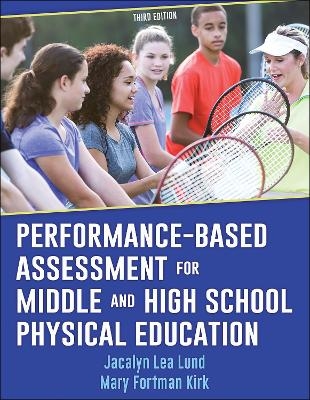
Performance-Based Assessment for Middle and High School Physical Education
Human Kinetics (Verlag)
978-1-4925-7017-2 (ISBN)
Performance-Based Assessment for Middle and High School Physical Education is a cutting-edge book that teachers trust for assessing middle school and high school physical education students. Also a highly popular undergraduate text for courses that focus on performance-based assessment, this new third edition features significant additions, enhancements, and updates:
New chapters on effective management and instruction delivery, which make it appropriate for PETE instructors using the book for secondary methods courses
A new chapter on assessments with various instructional models, including Sport Education, Teaching Games for Understanding, Cooperative Learning, Personalized System of Instruction, and Teaching Personal and Social Responsibility
A new chapter on assessing dance (with sample dance units in the web resource)
A new sample unit on ultimate Frisbee in the chapter on invasion games
An expanded section on cognitive assessments, with suggestions for writing tests
Updated content on rubrics
Performance-Based Assessment shows readers how to use portfolios to assess fitness, and it offers an example of a portfolio assessment for a high school fitness course. It also guides readers in using skill tests in physical education.
Written by two authors with a combined 26 years of experience teaching physical education in public schools, the text discusses various assessment formats, helping PETE students and in-service teachers know both what to assess and how to assess it. Readers learn how to develop culminating and progressive assessments, as well as plan for continuous performance-based assessments and acquire effective teaching strategies for standards-based instruction. All content is aligned with current SHAPE America national standards and is supported by research from educational assessment giants such as Tom Guskey, Richard Stiggins, Dylan William, Robert Marzano, and James Popham.
The book is organized into four parts, with part I introducing readers to performance-based assessment issues such as the need for change in the assessment process, how assessments can be used to enhance learning, the various assessment domains and methods, and the use of rubrics in assessments. Part II explores aspects of managing and implementing physical education lessons. In part III, readers learn about the components of performance-based assessment, and in part IV, they delve into issues affecting grading and implementing continuous performance-based assessment.
This groundbreaking text explains the theory behind assessment and, through its numerous models, shows how to apply that theory in practice. The text is filled with practical examples, much more so than the typical assessment book. And it is supplemented by a web resource that houses forms, charts, and other material for instructors to use in their performance-based assessments.
Class size, skill levels, and time factors can make assessments difficult—but far from impossible. The examples in the book are meant to be modified as needed, with the ideas in the book used as starting points.
Teachers can use the material, examples, and tools in this book to create assessments that enhance student learning, providing them feedback to let them know what they have accomplished and how they can work toward goals of greater competence.
Jacalyn Lea Lund, PhD, is a professor and the chair of the department of kinesiology and health at Georgia State University in Atlanta. She began her teacher educator career in 1990 following graduation from Ohio State University and had 16 years of teaching experience in public schools prior to that. She has presented on assessment at conferences and numerous workshops and has taught many classes on assessment in physical education. Dr. Lund has been a member of SHAPE America for over 40 years, most recently serving as the association’s president. She was on the committee that developed the organization’s 1995 content standards for physical education. In 2013 she was inducted into the SHAPE America Hall of Fame. She is a fellow of the National Academy of Kinesiology. Dr. Lund loves spending time with her family, dancing, reading, and, as she puts it, “having her dogs take her for a walk.” Mary Fortman Kirk, PhD, is a professor of physical education at Northern Kentucky University (NKU). She was an NKU department chair for eight years and is a former coordinator of the health and physical education programs. She also taught physical education at the high school level for 10 years. Dr. Kirk has given many presentations on portfolios and alternative assessment at conferences, including those of SHAPE America and the National Association for Physical Education in Higher Education. She was appointed by the Kentucky commissioner of education to serve on the state task force for the development of physical education assessment and performance assessment of new teachers. Dr. Kirk earned an MA in motor learning and physical education from Michigan State University in 1973 and a PhD in motor development and teacher preparation from Ohio State University in 1989. She is the author of two books on pre-sport development programs for the National Alliance for Youth Sports and for the Girl Scouts of the USA.
Part I. Introduction to Performance-Based Assessment
Chapter 1. The Need for Change
The Call for Change in Education
Standards-Based Instruction
Types of Assessment in Standards-Based Instruction
Effect on Teaching When Standards Are Used
Role of Assessment in Physical Education Programs
Changing the Assessment Culture in Physical Education
Conclusion
Chapter 2. Assessing the Psychomotor Domain to Enhance Student Learning
Purpose of Assessment
What Are Performance-Based Assessments?
Characteristics of Performance-Based Assessment
Types of Performance-Based Assessments
Advantages of Using Performance-Based Assessments
Concerns When Using Performance-Based Assessments
Conclusion
Chapter 3. Using Cognitive and Affective Learning Domain Assessments Effectively in Physical Education
Traditional Test Questions Used for Cognitive and Affective-Domain Assessments
Selected-Response Questions
Performance-Based Assessments for Cognitive and Affective-Domain Learning
Projects
Journals
Role Plays
What Are Open-Response Questions?
Comparing Open-Response and Essay Questions
Characteristics of Open-Response Questions
Types of Open-Response Questions
How to Write Open-Response Questions
Suggestions for Using Open-Response Questions
Conclusion
Chapter 4. Rubrics
What Is a Rubric?
Benefits of Using Rubrics
Criteria for Rubrics
Choosing the Most Appropriate Rubric
How to Create Quantitative Rubrics
How to Create Qualitative Rubrics
Special Considerations in Creating Rubrics
Rubric Hints and Guidelines
Conclusion
Part II. Managing and Implementing Physical Education Lessons
Chapter 5. Creating a Classroom Climate That Supports Standards-Based Instruction
Creating a Positive Learning Environment
Teacher Expectations
The Importance of Having a Good Learning Climate
Structuring the Classroom Environment
Working With Equipment
Managing Space
Managing Time
Developing Rules for Physical Education Classes
Reinforcing Behaviors
Rewarding Positive Behaviors
Disciplining Students
Conclusion
Chapter 6. Effective Teaching Strategies for Standards-Based Instruction
The Complexity of Games and Physical Activities
How Much to Include in Your Unit of Instruction
Application Tasks
Presenting Learning Tasks
Monitoring Student Learning
Asking Questions in Physical Education
Resources During Instruction
Pacing and Opportunity to Respond
Applying Motor Learning Concepts While Teaching
Conclusion
Chapter 7. Assessing With Instructional Models
Direct Instruction
Sport Education Instructional Model (IM)
Tactical Games or Teaching Games for Understanding Instructional Model (IM)
Cooperative Learning
Personalized System of Instruction
Teaching Personal and Social Responsibility
Conclusion
Part III. Components of Performance-Based Assessment
Chapter 8. Developing Culminating and Progressive Assessments
Culminating (Summative) Assessments
Progressive Learning Activities and Assessments
Tumbling Unit
Target Archery Unit
Golf Unit
Soccer Unit
Conclusion
Chapter 9. Planning for Continuous Performance-Based Assessment
Major Unit Focus
Culminating (Summative) Assessment and Evaluation Rubric
Essential Knowledge, Skills, and Abilities
Progressive Learning Activities and Formative Assessments
Critical Resources
Planning Lessons From the Unit Plan
Conclusion
Chapter 10. Developing Standards-Based Units of Instruction for Invasion Sports
Major Soccer Unit Focus
Culminating (Summative) Assessment and Evaluation Rubric
Essential Soccer Knowledge, Skills, and Abilities
Progressive Learning Activities and Formative Assessments
Critical Resources
How to Use the Student Soccer Portfolio
Ultimate: Standards-Based Unit of Instruction
Major Ultimate Unit Focus
Culminating or Summative Assessment and the Evaluation Rubric
Essential Ultimate Knowledge, Skills, and Abilities
Progressive Learning Activities and Formative Assessments
Critical Resources
Conclusion
Chapter 11. Using Portfolios to Assess Physical Activities and Fitness
Types of Portfolios
Advantages of Using Portfolio Assessment
Disadvantages of Using Portfolios
Portfolio Guidelines in Performance-Based Assessment
Evaluating Portfolios
Integrating Fitness Education and Assessment Into the Physical Education Curriculum
Resources for Fitness Education Curriculum, Instructions, and Assessment
Using Technology to Assess Physical Activity Participation Levels
High School Fitness Portfolio
Conclusion
Chapter 12. Using Standards-Based Instruction to Teach Dance
Why Include Dance in Physical Education?
Planning a Dance Unit
Teaching Structured Dance
Teaching Creative Dance
Teaching Social Dance
Using Portfolios to Assess Dance
Conclusion
Part IV. Grading and Implementing Continuous Performance-Based Assessment
Chapter 13. Effective Grading in Physical Education
Purposes of Grading and Grade Reporting
Developing a Meaningful Grading System
Problems With Traditional Grading Practices
Grade Formats in Physical Education
Effective Grading in Physical Education
Grading Before You Have a Rubric Developed
Challenges in Using Effective Grading Practices
Grading Practices for Students With Special Needs
Hints and Suggestions for More Effective Grading Practices
Conclusion
Chapter 14. Acquiring Assessment Savvy
Planning the Assessment Process
Lund and Kirk’s Tips for Acquiring Assessment Savvy
Conclusion
| Erscheinungsdatum | 27.03.2019 |
|---|---|
| Verlagsort | Champaign, IL |
| Sprache | englisch |
| Maße | 216 x 279 mm |
| Gewicht | 1043 g |
| Themenwelt | Sachbuch/Ratgeber ► Gesundheit / Leben / Psychologie |
| Schulbuch / Wörterbuch | |
| Sozialwissenschaften ► Pädagogik | |
| Weitere Fachgebiete ► Sportwissenschaft | |
| ISBN-10 | 1-4925-7017-6 / 1492570176 |
| ISBN-13 | 978-1-4925-7017-2 / 9781492570172 |
| Zustand | Neuware |
| Informationen gemäß Produktsicherheitsverordnung (GPSR) | |
| Haben Sie eine Frage zum Produkt? |
aus dem Bereich


